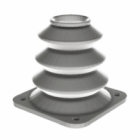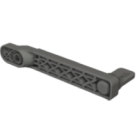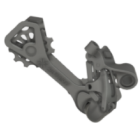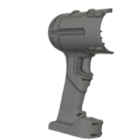How big can 3D printers print?
One of the most common questions in additive manufacturing is: how big can 3D printers print? The answer isn’t simple, because it depends entirely on the type of printer, technology used, and the purpose of the print. From small desktop units to room-sized industrial machines — and even mobile printers used in construction — the maximum size for 3D printing can vary from a few centimeters to several meters.
This section explains what defines the printable volume in different technologies, what limitations apply, and how engineers overcome them when large-scale prints are required.
Build volume – the real constraint
Every 3D printer has a defined build volume, which is the maximum space in which it can produce a part. For most desktop FDM printers, that volume ranges from 200 × 200 × 200 mm to about 300 mm on each axis. Professional printers might reach 500 mm or more, and some large-format machines like the BigRep PRO or Modix series can produce objects over one meter long in a single piece.
However, even industrial SLS or SLA systems have physical size limitations — usually dictated by the gantry size, heating systems, and powder distribution methods. The same is true for DMLS metal printers, where chamber size is limited by the need for precision control and inert gas environments.
Segmenting large parts for assembly
When parts need to exceed the 3D printing maximum size of a given machine, the standard approach is to split the model into smaller, printable segments. These pieces can later be bonded, welded, or mechanically joined. This method is common in automotive and aerospace industries, where large components must meet dimensional constraints without sacrificing design complexity.
Designing for segmented assembly also allows for internal features, reinforcement strategies, and easier post-processing — although it requires extra time in CAD and careful planning for alignment and strength.
The largest 3D printed structures
For special applications like architecture, construction, or aerospace tooling, custom-built printers are pushing the boundaries of what’s possible. Some of the largest 3D printed structures in the world include full-scale concrete houses, pedestrian bridges, and wind turbine blades.
| Technology | Typical build volume | Large-format examples | Use case |
|---|---|---|---|
| FDM (Fused Deposition Modeling) | 200 × 200 × 200 mm → 500 × 500 × 500 mm | Up to 1000 × 1000 × 1000 mm (e.g., BigRep, Modix) | Prototypes, tooling, furniture |
| SLA/DLP (resin printing) | 120 × 68 × 150 mm → 300 × 300 × 400 mm | Limited scalability due to resin tank and accuracy | Dental, jewelry, high-detail models |
| SLS (Selective Laser Sintering) | 300 × 300 × 300 mm → 700 × 380 × 580 mm | EOS P770: 700 mm long prints | Functional prototypes, mechanical parts |
| DMLS/SLM (metal printing) | 150 × 150 × 150 mm → 500 × 280 × 365 mm | GE Concept Laser X LINE 2000R (industrial-grade) | Aerospace, implants, tooling |
| Concrete / construction 3D printing | Typically 6–10 m length / 3–4 m height | COBOD BOD2: Prints 300 m² buildings on-site | Houses, bridges, architectural walls |
For example, COBOD and ICON have created printers that can produce multi-meter-wide walls for buildings directly on-site, layer by layer. In aerospace, 3D-printed tooling for carbon fiber layups can stretch several meters, helping reduce weight and cost in composite part manufacturing.
These examples show that while standard machines have limits, large-format 3D printing is evolving quickly — often through custom hardware built around specific needs.
Factors affecting print size in practice
Beyond the printer’s hardware limits, other factors also influence how large an object can be successfully 3D printed. These include:
- material behavior – warping, shrinkage, and curing stresses increase with part size,
- print time – larger prints can take dozens or even hundreds of hours to complete,
- structural stability – tall or bulky prints may need additional support, anchors, or internal frameworks,
- post-processing needs – bigger parts require more space and handling for cleaning, curing, or finishing.
For this reason, scaling up a print isn’t just a matter of available volume — it’s also a question of engineering stability and workflow management.
So, how big can 3D printers print? Technically — as big as the hardware allows. Practically — as big as your design, materials, and resources can support. From small machine components to large-format construction elements, additive manufacturing gives you options across the size spectrum. The key is to match your goals with the right process, printer, and design strategy.
FAQ: How big can you 3D print?
The maximum build size of a 3D printer depends entirely on the technology and printer class. Desktop FDM printers typically max out around 300 x 300 x 400 mm, while large 3D printers like BigRep can 3D print large objects exceeding 1 meter per axis. For construction or aerospace tooling, large format construction printers can produce structures several meters long — even entire houses. Ultimately, how big you can 3D print something depends on printer size, materials, and project scope.
3D printer sizes vary from compact desktop models that fit on a table to room-sized industrial printers. Entry-level machines are often under 50 cm in all dimensions, while large format 3D printers can take up several square meters of floor space. The size of the printer usually correlates with its maximum build volume, but not always — resin machines, for example, can be large but still have a small printing area due to resin tank limitations.
Most 3D printers can achieve detail down to 50–200 microns (0.05–0.2 mm), depending on the nozzle, material, and technology. SLA and DLP resin printers offer the best small-feature resolution, making them suitable for applications like jewelry or dental. However, even SLS or FDM systems can handle fine features with proper calibration. The smallest printed parts can be just a few millimeters in size with high accuracy. (In micro-SLA systems, features can reach micrometer — and even nanometer — resolution.)
To 3D print large objects, you’ll need either a printer with a large build volume or a strategy for splitting your design into smaller parts. Most industrial users divide large models into sections for segmental assembly after printing. If your application involves prototypes, furniture, or tooling, look into large format FDM printers. For strong, detailed parts, SLS systems also offer significant size capacity in nylon materials.
The right printer size depends on what you intend to produce. If you’re prototyping small mechanical parts, a standard desktop FDM or resin printer may be sufficient. For manufacturing fixtures, furniture, or large format parts, you’ll need a machine with at least 500–1000 mm on one or more axes. Choosing your printer based on maximum build size ensures you’re not constrained during the design process.
Large format 3D printers come in various forms depending on the technology. FDM machines like BigRep and Modix specialize in large prototypes and tooling. Large format resin 3D printers exist but are rare due to material and tank limitations. In construction, concrete 3D printers such as COBOD’s BOD2 can print building-scale structures on-site. Some SLS systems (e.g., EOS P770) offer extended build volumes for nylon-based large parts.
Among commercially available models, printers like COBOD BOD2 and ICON’s Vulcan top the list — capable of printing multi-meter-wide walls for homes and infrastructure. In the plastic sector, BigRep PRO and Modix BIG-Meter support 1000 x 1000 x 1000 mm volumes. For metal, the GE Concept Laser X LINE 2000R offers one of the largest 3D printing metal maximum size capacities available.
Large-format prints often require dedicated post-processing equipment like industrial bead blasters, heated ovens for sintering or annealing, or oversized wash and cure stations (especially for resin prints). In powder-based systems, automated depowdering stations are essential to handle large parts safely and cleanly. The bigger the part, the more critical ergonomics and workflow efficiency become in post-processing.
Yes — there are still practical and technical limitations. Build volume, material behavior (e.g., warping, shrinkage), and print time all affect feasibility. In many cases, designing for modularity and segmenting large parts is the only way to go. Also, not all materials are available for large 3D printer systems; for example, large format resin 3D printers are rare due to resin handling constraints.
Build volume refers to the actual printable space inside the machine. Printer size, on the other hand, includes the hardware footprint. A printer might be physically large due to its powder system, resin tank, or enclosed chamber, yet have a smaller build volume. Always check maximum build size before purchase.
Technically, no — but practically, yes. Print success depends on geometry, material, printer type, and post-processing workflow. Very thin walls, unsupported overhangs, and complex internal channels might require design changes or advanced machines.
For polymer printing: FDM giants like BigRep and Modix dominate. For SLS, look at EOS or Sinterit large-chamber systems. In metal: GE Additive and Desktop Metal offer large-format DMLS solutions. And for construction: companies like COBOD or ICON build printers for walls and full-size structures.
Explore also
- How to design for 3D printing?
- 3D printing overhangs
- What is resolution in 3D printing?
- Wall thickness 3D print
- Tolerances for 3D printing
- Support 3D print
Related categories













